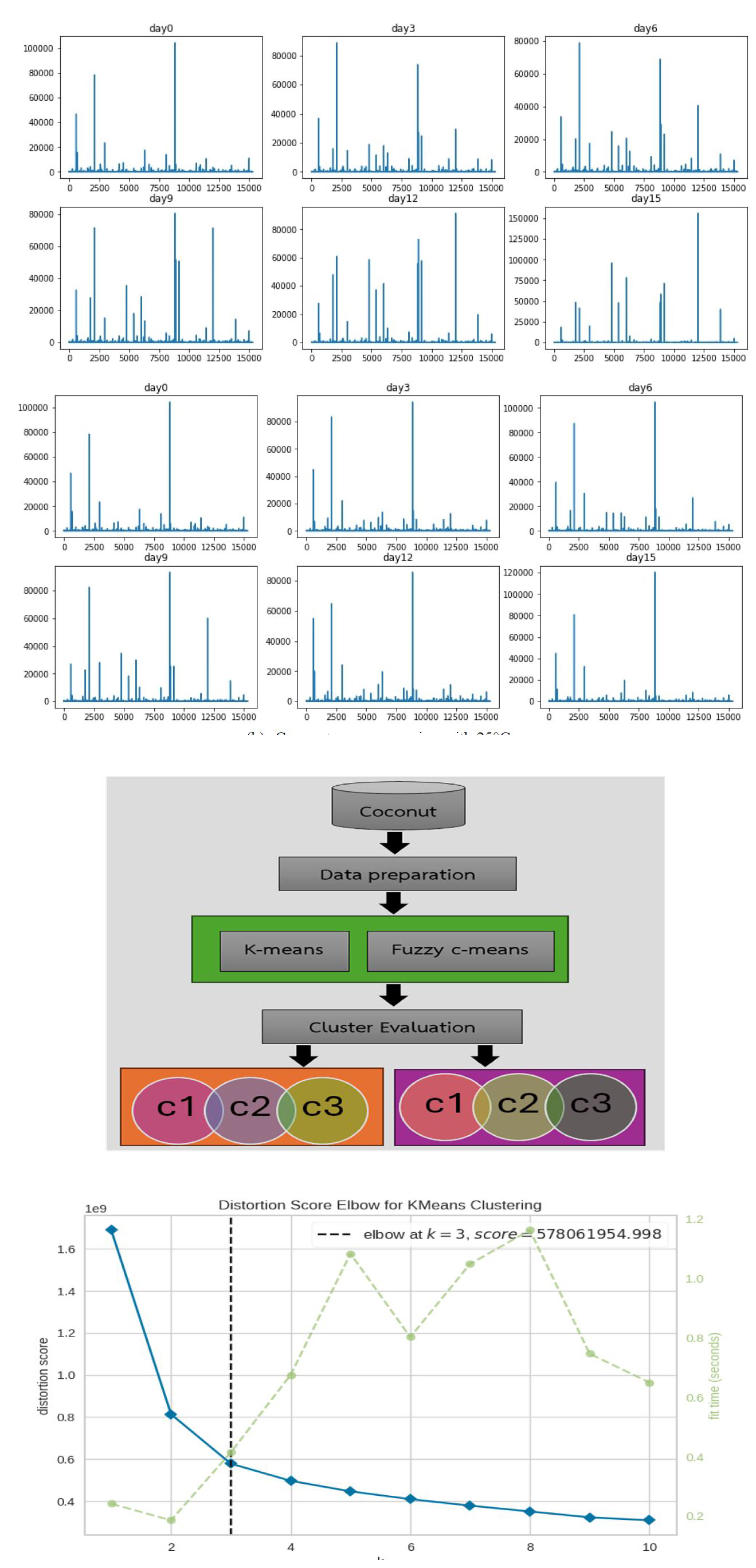The Efficacy of Clustering Algorithms for Young ‘Nam-Hom’ Coconut Gene Expression Data in Unveiling the Specific Genes Determining the Flavor: A Comparative Analysis of K-means and Fuzzy C-means
DOI:
https://doi.org/10.53848/ssstj.v11i2.806Keywords:
Young ‘Nam-Hom’ coconut, Gene expression data, Clustering algorithmsAbstract
This study explores the application of K-means and Fuzzy C-means clustering techniques to analyze gene expression data related to the flavor of young ‘Nam-Hom’ coconuts. By comparing these clustering methods, the research aims to identify gene clusters that significantly influence the aromatic and off-flavor profiles of young ‘Nam-Hom’ coconuts stored at different temperatures (4°C and 25°C). Specifically, our findings highlight clusters involved in lipid metabolism and cold stress response which are crucial for developing desirable and undesirable flavors, such as LOX1 and ADH2 genes. The study advances our understanding of coconut genetics demonstrates the utility of clustering techniques in agricultural genomics, offering valuable pathways for future genetic enhancement and storage optimization strategies aimed at improving coconut aroma.
References
References
Alagukumar, S., & Lawrance, R. (2015). A selective analysis of microarray data using association rule mining. Procedia Computer Science, 47, 3-12. doi:10.1016/j.procs.2015.03.177
Bezdek, J. C., Ehrlich, R., & Full, W. (1984). FCM: The fuzzy c-means clustering algorithm. Computers & Geosciences, 10(2-3), 191-203. doi:10.1016/0098-3004(84)90020-7
Hengpraprohm, S., Jungjit, S., Hengpraprohm, K, & Thammasiri, D. (2019). Molecular marker discovery for ovarian maturation level of the black tiger shrimp from microarray data using genetic algorithm. International Journal of the Computer, the Internet and Management, 27(2), 43-51.
Meethaworn, K. (2021). Cracking characteristic on polished young coconut and its prevention. Proceedings of the 13th NPRU National Academic Conference (pp. 209-216). Nakhon Pathom, Thailand (in Thai).
Meethaworn, K., Imsabai, W., Zhang, B., Chen, K., & Siriphanich, J. (2022). Off-flavor and loss of aroma in young coconut fruit during cold storage are associated with the expression of genes derived from the LOX pathway and Badh2. The Horticulture Journal, 91(2), 209-220. doi:10.2503/hortj.UTD-309
Meethaworn, K., Luckanatinwong, V., Zhang, B., Chen, K., & Siriphanich, J. (2019). Off-flavor caused by cold storage is related to induced activity of LOX and HPL in young coconut fruit. LWT, 114, 108329.
doi:10.1016/j.lwt.2019.108329
Mohpraman, K., & Siriphanich, J. (2012). Safe use of sodium metabisulfite in young coconuts. Postharvest Biology and Technology, 65, 76-78.
Office of Agricultural Economics. (2024). Amount and economic value of aromatic coconut. Retrieved from http://www.infoservice@oae.go.th
Pakcharoen, A., Meethaworn, K., & Mohpraman, K. (2012). The occurrence and deterrence of fruit cracking and off-flavor in aromatic coconut during storage at low temperature (Report No. KU.R.1/2011). Postharvest Technology Innovation Center (in Thai).
Saensuk, C., Wanchana, S., Choowongkomon, K., Wongpornchai, S., Kraithong, T., Imsabai, W., … Arikit, S. (2016). De novo transcriptome assembly and identification of the gene conferring a “pandan-like” aroma in coconut (Cocos nucifera L.). Plant Science, 252, 324-334. doi:10.1016/j.plantsci.2016.08.014
Shahapure, K. R., & Nicholas, C. (2020). Cluster quality analysis using Silhouette Score. 2020 IEEE 7th International Conference on Data Science and Advanced Analytics (pp. 747-748). Sydney, Australia.
doi:10.1109/DSAA49011.2020.00096
Sinaga, K. P., & Yang, M.-S. (2020). Unsupervised k-means clustering algorithm. IEEE Access, 8, 80716-80727. doi:10.1109/ACCESS.2020.2988796
Siriphanich, J., Saradhuldhat, P., Romphophak, T., Krisanapook, K., Pathaveerat, S., & Tongchitpakdee, S. (2011). Coconut (Cocos nucifera L.). In E. M. Yahia (Ed.), Postharvest biology and technology of tropical and subtropical fruits. Woodhead Publishing.
Yong, J. W. H., Ge, L., Ng, Y. F., & Tan, S. N. (2009). The chemical composition and biological properties of coconut (Cocos nucifera L.) water. Molecules, 14, 5144-5164. doi:10.3390/molecules14125144
Zhu, P., Zhu, W., Hu, Q., Zhang, C., & Zuo, W. (2017). Subspace clustering guided unsupervised feature selection. Pattern Recognition, 66, 364-374. doi:10.1016/j.patcog.2017.01.016

Downloads
Published
How to Cite
Issue
Section
License
Copyright (c) 2024 Suan Sunandha Rajabhat University

This work is licensed under a Creative Commons Attribution 4.0 International License.











